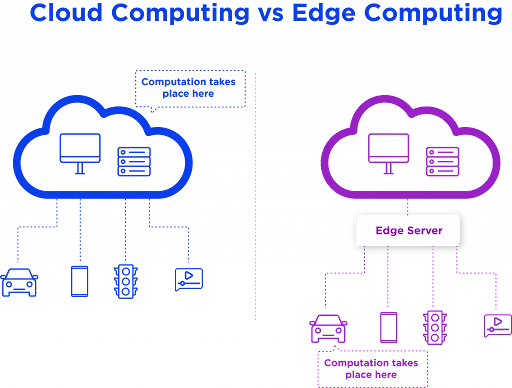
Edge Computing and Cloud Computing are two approaches to data processing, storage, and computation, but they differ significantly in terms of where and how data is processed. Here’s a detailed comparison:
1. Definition
- Edge Computing: Data is processed close to the source of generation (e.g., IoT devices, local servers).
- Example: An autonomous car processes sensor data locally to make real-time decisions.
- Cloud Computing: Data is processed and stored in centralized data centers accessed over the internet.
- Example: Storing files on Google Drive or running an application on AWS.
2. Key Differences
| Feature | Edge Computing | Cloud Computing |
|---|---|---|
| Location of Processing | Near the data source (e.g., devices, local servers). | Centralized data centers, often far from users. |
| Latency | Low latency (real-time processing). | Higher latency (dependent on network). |
| Reliability | Operates even with intermittent internet. | Requires consistent internet connectivity. |
| Scalability | Limited by local hardware capacity. | Virtually unlimited scalability. |
| Cost | Higher upfront cost (hardware deployment). | Pay-as-you-go model; cost-effective for scale. |
| Privacy | Processes data locally, improving privacy. | Data must travel to centralized servers. |
| Use Cases | Real-time systems (e.g., IoT, autonomous cars). | General-purpose applications (e.g., SaaS, storage). |
3. Advantages
Edge Computing
- Reduced Latency: Faster response times for critical operations.
- Bandwidth Savings: Reduces data transmission to the cloud.
- Improved Privacy: Local processing minimizes data exposure risks.
- Offline Functionality: Operates even without continuous internet access.
Cloud Computing
- Scalability: Easily scale resources up or down.
- Centralized Management: Easier maintenance and updates.
- Cost-Effectiveness: Pay for resources as needed.
- Global Accessibility: Access data and applications from anywhere.
4. Disadvantages
Edge Computing
- Higher Upfront Costs: Requires investment in edge devices and infrastructure.
- Limited Resources: Processing power depends on local hardware capabilities.
- Complexity: Requires managing multiple distributed devices.
Cloud Computing
- Latency: Slower for time-sensitive applications due to data transmission delays.
- Privacy Concerns: Data travels to and from centralized servers, increasing exposure.
- Internet Dependency: Requires consistent and fast internet connectivity.
5. Use Cases
Edge Computing
- Autonomous Vehicles: Real-time processing for navigation and safety.
- Smart Cities: Localized traffic management and public safety systems.
- Industrial IoT: Machine monitoring and predictive maintenance.
- AR/VR: Low-latency applications for immersive experiences.
Cloud Computing
- Web Hosting: Websites and web applications.
- Big Data Analytics: Processing and analyzing large datasets.
- Enterprise Applications: CRM, HR, and other SaaS solutions.
- Content Delivery: Streaming platforms and global file storage.
6. Hybrid Use Case
Many organizations adopt a hybrid model, combining edge and cloud computing:
- Example: A retail chain uses edge computing for in-store analytics while syncing aggregated data to the cloud for broader analysis and backup.
7. Choosing Between Edge and Cloud
- Use Edge Computing when:
- Real-time processing is critical.
- Bandwidth costs need to be minimized.
- Privacy and data sovereignty are priorities.
- Use Cloud Computing when:
- Scalability and flexibility are needed.
- Data doesn’t require immediate processing.
- Centralized management is preferred.




